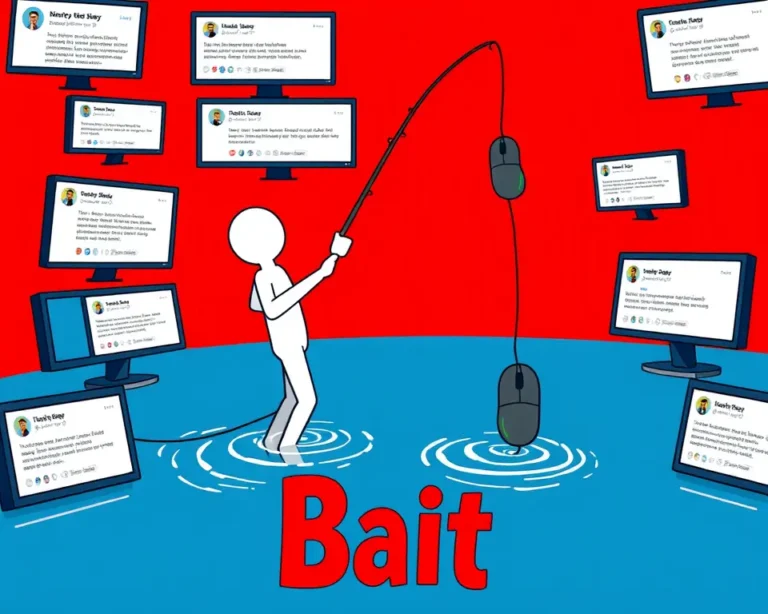The phrase “it’s bait” has become a common expression online, particularly in social media and gaming contexts. But what does it actually mean, and where did it come from? This article explores the various meanings of “it’s bait,” its origins, and how it’s used in different situations.
The Core Meaning of “It’s Bait”
At its core, “it’s bait” or simply “bait” implies that something is obvious, deliberately provocative, or intended to elicit a reaction. The term suggests that a statement, question, or action is designed to “lure” someone into a specific response, often an argument or display of emotion.
Different Interpretations and Contexts
The meaning of “it’s bait” can vary depending on the context, but some common interpretations include:
- Obviousness: In some cases, “it’s bait” simply means that something is very obvious or easily understood.
- Provocation: More often, it indicates that something is intended to provoke a reaction, whether positive or negative. This could be a controversial opinion, a deliberately inflammatory statement, or a leading question.
- Trolling: “Bait” is often associated with trolling, where someone intentionally posts something to upset or anger others.
- Manipulation: The phrase can also suggest that someone is being manipulative, using a statement or action to get someone to do what they want.
Origins of “It’s Bait”
The exact origin of the phrase “it’s bait” is difficult to pinpoint, but its roots can be traced to several sources:
Fishing Terminology
The word “bait” itself comes from the Old Norse word “beita,” meaning “food” or “lure,” especially for fish. This connection to fishing is fundamental to understanding the phrase’s meaning, as it implies that something is being used to “hook” or attract someone.
UK Slang
“Bait” has been used as slang in the UK, particularly in London, to mean “obvious” or “exposed.” This usage aligns with the idea that something is so blatant that it’s clearly intended to provoke a response.
Online Culture
The rise of internet culture and social media has played a significant role in popularizing “it’s bait.” The anonymity and distance afforded by the internet have made it easier for people to engage in provocative behavior, and the phrase has become a way to call out such tactics.
“It’s Bait” in Action: Examples and Usage
To better understand how “it’s bait” is used, here are some examples:
- Social Media: Someone posts a controversial opinion about a popular movie, knowing it will spark debate. Another user might comment, “That’s just bait.”
- Online Gaming: A player intentionally makes a risky move to lure opponents into a trap. A teammate might say, “Don’t fall for it, it’s bait!”
- Politics: A politician makes a statement designed to anger their opponents and rally their supporters. A commentator might describe it as “obvious bait.”
- Personal Interactions: Someone makes a teasing or provocative remark to get a rise out of a friend. The friend might respond, “Stop trying to bait me!”
Common Scenarios
- Cybersecurity: Baiting in cybersecurity involves luring victims with attractive offers or rewards to trick them into downloading malware or revealing sensitive information. Examples include fake ads offering free software or USB drives left in public places that contain malicious software.
- Social Engineering: Attackers exploit human curiosity or greed by offering enticing items or content, such as free movie downloads or exclusive content, which lead to compromising security.
- Phishing: While not exclusively baiting, phishing attacks often incorporate baiting elements by creating messages that appear legitimate, such as banking alerts or package delivery notifications, to lure recipients into clicking links or entering credentials.
Recognizing and Avoiding “Bait”
Being able to recognize when something is “bait” is crucial for navigating online interactions and avoiding unnecessary conflict. Here are some tips:
- Consider the Source: Is the person known for being provocative or controversial?
- Analyze the Intent: Does the statement seem designed to elicit a specific reaction?
- Don’t Take the Bait: If you suspect something is bait, resist the urge to respond emotionally.
- Think Before You Type: Before reacting, take a moment to consider whether your response is what the person is hoping for.
- Walk Away: Sometimes, the best response is no response at all.
The Dangers of Taking the Bait
Responding to “bait” can have several negative consequences:
- Fuels Conflict: Engaging with provocative statements often escalates arguments and creates unnecessary drama.
- Wastes Time and Energy: Arguing with someone who is intentionally trying to provoke you is rarely productive and can be emotionally draining.
- Gives the Baiter Satisfaction: Responding to bait gives the person who posted it the attention they were seeking, reinforcing their behavior.
- Compromises Security: Clicking on malicious links or downloading infected files from baiting attempts can lead to malware infections or data theft.
“Rage Bait”
“Rage bait” is a specific type of bait designed to provoke anger and outrage. These posts often contain inflammatory opinions, misinformation, or outright lies, with the goal of generating strong emotional responses and driving engagement.
Identifying Rage Bait
- Sensational Headlines: Rage bait often uses exaggerated or shocking headlines to grab attention.
- Emotional Language: The content is filled with emotionally charged words and phrases designed to provoke anger.
- Lack of Evidence: Rage bait often presents claims without providing credible evidence or sources.
- Appeals to Emotion: The content appeals to emotions rather than logic or reason.
Responding to Rage Bait
The best way to deal with rage bait is to ignore it. Engaging with these posts only amplifies their reach and gives the creators the attention they crave. If you feel compelled to respond, do so calmly and rationally, providing factual information and avoiding emotional language.
“Clickbait”
Clickbait is a technique used to entice users to click on a link, often leading to websites filled with ads or low-quality content. While not always malicious, clickbait can be annoying and misleading.
Identifying Clickbait
- Sensational Headlines: Clickbait headlines often use sensational language and promise unbelievable results.
- Vague or Mysterious Language: The headlines are often vague or mysterious, designed to pique curiosity.
- Misleading Images: Clickbait often uses images that are unrelated to the content of the article.
- Exaggerated Claims: The headlines promise something that the article cannot deliver.
Avoiding Clickbait
- Be Skeptical: Be wary of headlines that seem too good to be true.
- Check the Source: Consider the reputation of the website or source before clicking on a link.
- Read Carefully: Before clicking, read the headline and blurb carefully to see if they provide enough information.
- Use Ad Blockers: Ad blockers can help prevent clickbait ads from appearing on websites.
Bait in the Context of Relationships
Baiting can also occur in personal relationships, where one person intentionally provokes another to create conflict or exert control. This can involve:
- Teasing: Making fun of someone’s insecurities or vulnerabilities.
- Criticism: Constantly finding fault with someone’s actions or behavior.
- Jealousy: Trying to make someone jealous by flirting with others.
- Guilt-Tripping: Making someone feel guilty for not doing what you want.
Addressing Baiting in Relationships
If you’re being baited in a relationship, it’s important to:
- Recognize the Pattern: Identify the specific behaviors that are used to provoke you.
- Set Boundaries: Clearly communicate your limits and what you will not tolerate.
- Stay Calm: Avoid reacting emotionally to the baiting attempts.
- Seek Support: Talk to a trusted friend, family member, or therapist about the situation.
- Consider Ending the Relationship: If the baiting continues and is causing significant harm, it may be necessary to end the relationship.
Conclusion
“It’s bait” is a versatile phrase that reflects the complexities of online communication and human interaction. Whether it’s used to call out obvious trolling, warn against manipulative tactics, or simply acknowledge a provocative statement, understanding the meaning and origins of “it’s bait” can help you navigate the digital world with greater awareness and discernment.







